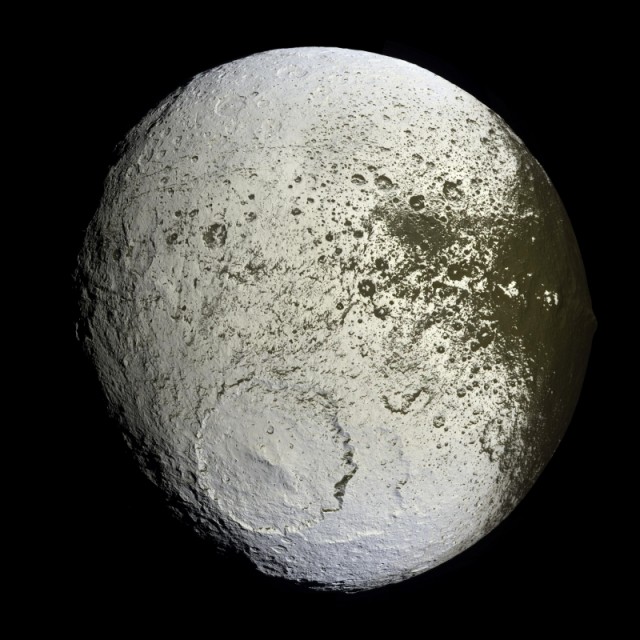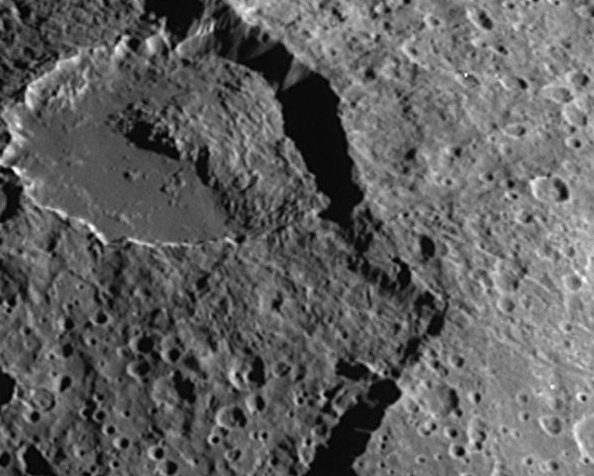
Saturn's moon Iapetus has many unique features that stand out even among the odd Solar System satellites. Its shape is very walnut-like: flattened at the poles, bulging strongly at the equator, with an equatorial mountain ridge nearly 20 kilometers high running about three-quarters of its circumference. Unlike any other known object, the face that points in the direction of its motion is dark in color, while the trailing face is bright white. Some of these mysteries have plausible solutions, but others remain unsolved.
A new observation described by Kelsi N. Singer, William B. McKinnon, Paul M. Schenk, and Jeffery M. Moore adds to Iapetus' marvelous weirdness. Analyzing images from the Cassini space probe, they found huge ice avalanches on the moon's surface. These avalanches are known as long-runout because they extend much farther than a typical landslide. Because Iapetus has no atmosphere or groundwater—implicated in some long-runout landslide models—the researchers concluded local melting of ice reduces the friction, allowing the rubble to travel great distances with little resistance.
Unlike many other icy moons of similar size, Iapetus has a great deal of topological variation. Beyond the tall equatorial ridge, it has extremely large impact craters, some as deep as 25km. With such drastic contrasts between highlands and basins, Iapetus is among the most geologically rugged bodies in the Solar System. Its composition is largely ice, and its overall density is barely larger than water's.

The key to identifying landslides (assuming one doesn't witness them actually happening) is distinguishing "avalanche scars" from other landscape features. Such scars may be collapsed crater edges, runouts descending from steep ridges, and (if image resolution is high enough) visible jumbles of boulders and other debris. The researchers in the present study identified 30 distinct landslides, 17 of which were at crater rims, with the remaining 13 associated with the equatorial ridge. Eighteen additional avalanche candidates were identified, which (if confirmed) would mean Iapetus has the largest number of known landslide events in the whole Solar System.
The landslides themselves were impressive, all falling into the long-runout category. The shortest in the sample was 7km (limited by the resolution of the Cassini images) and the longest was 80km, which rivals a similar runout in the Valles Marineris canyon on Mars—and certainly exceeds anything on Earth. Additionally, the researchers measured the ratio of the length of each runout to its height, which is the measure of the landslide's mobility. The inverse ratio is a good estimate of the coefficient of friction—the amount of resistance two surfaces have when sliding across each other. A high mobility and low coefficient of friction indicates an extremely slippery interface.
The researchers found a remarkable consistency in their estimated coefficients of friction: 0.1 to 0.3, regardless of the length of a given landslide event. That indicates the physical mechanisms at work inside all the slides were similar. On Earth, terrestrial landslides have coefficients significantly larger than 0.3, while mudslides or undersea avalanches are much less than 0.1; neither of these scenarios correspond to conditions on Iapetus. The Iapetian (yes, that's the proper adjective) values are also lower than the laboratory measurement for two blocks of cold water ice sliding across each other, even at high pressures (these are between 0.55 and 0.7).
On Earth and Mars, low coefficients of friction are associated with water or trapped gases below the avalanche. Iapetus is too cold for liquid water to persist, and there is no atmosphere to supply the gas, so what could possibly be going on? The authors propose that the high pressures and friction may melt the ice at the interface, making the surface that the landslide travels along much less frictional than a dry surface. (They wryly comment, "as commonly experienced, ice is slippery.")
Whether the simple ice melt model holds for long-runout landslides on other worlds, the presence of such avalanches on Iapetus adds to the unique character of the moon.
Nature Geoscience, 2012. DOI: 10.1038/ngeo1526 (About DOIs).
reader comments
32